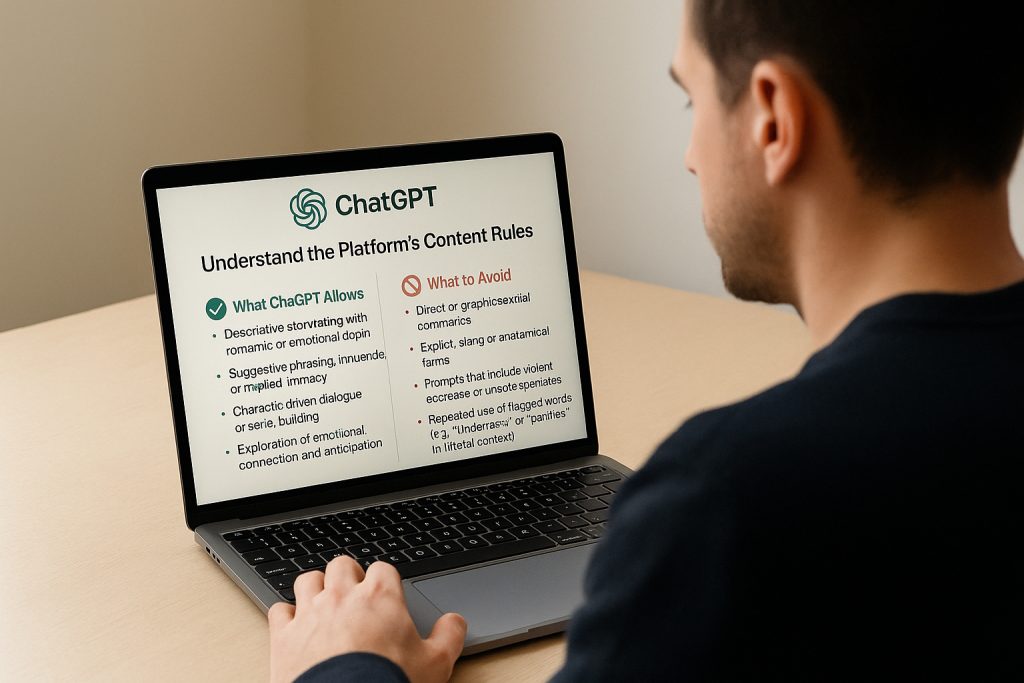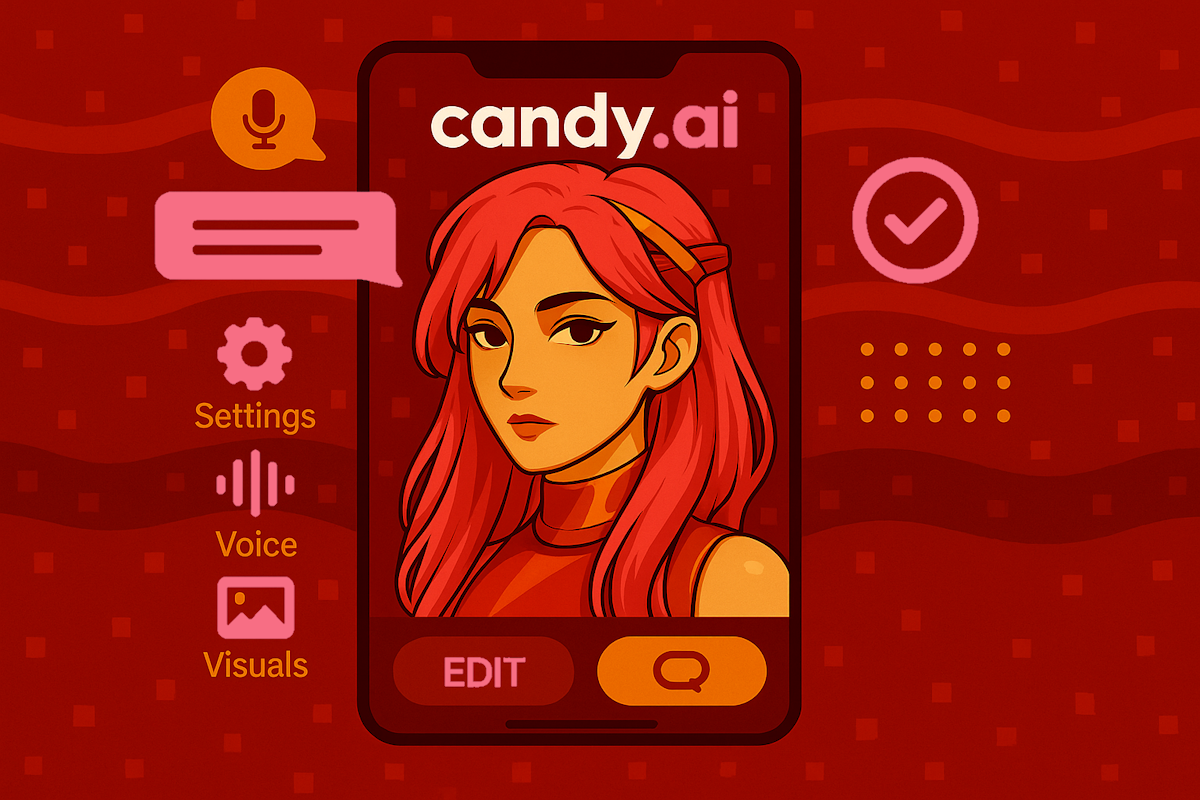Erotic roleplay with AI tools like ChatGPT can be surprisingly engaging if done with thought and creativity. While ChatGPT is designed to follow strict content policies and avoid explicit content, users can still guide it into immersive, emotionally charged conversations using storytelling techniques, careful language, and progressive cues.
This guide explains how to approach erotic roleplay with ChatGPT while respecting its boundaries. Whether you’re writing a romantic story, exploring character intimacy, or just curious how to build tension without crossing the line, this article breaks it all down into practical steps.

Understand the Platform’s Content Rules
Before anything else, you need to know what ChatGPT won’t do. The model is trained to reject direct sexual content and certain explicit keywords. However, it can participate in fictional, character-driven conversations that include subtle emotional tension, sensual overtones, and suggestive scenes when they are written in a non-explicit way.
What ChatGPT Allows
- Descriptive storytelling with romantic or emotional depth
- Suggestive phrasing, innuendo, or implied intimacy
- Character-driven dialogue or scene-building
- Exploration of emotional connection and anticipation
What to Avoid
- Direct or graphic sexual commands
- Explicit slang or anatomical terms
- Prompts that include violent, coercive, or unsafe scenarios
- Repeated use of flagged words (e.g. “nude,” “sex,” or “panties” in a literal context)

Explore Roleplay More Freely with Seductive AI
At Seductive AI, we’ve built a space where erotic roleplay isn’t just allowed – it’s the whole point. Unlike general AI tools that are limited by strict content filters, our platform is designed specifically for adult conversations, romantic storytelling, and emotionally layered interactions. You can create and chat with AI characters that respond to mood, tone, and pacing in a way that feels natural and immersive.
If you’re practicing your roleplay skills or looking for a place to explore your fantasies without the usual limitations, Seductive AI offers a flexible environment where creative expression isn’t filtered out. We give you the tools to engage in detailed conversations, develop character dynamics, and experiment with scenarios that match your personal style.
Build the Foundation First
Don’t dive directly into intimacy. Instead, create an atmospheric opening that introduces characters and environment. Think like a novelist setting the stage.
Strong Openings Could Include:
- “The fire crackled softly, casting a glow across the room as she leaned back on the velvet couch.”
- “They sat side by side on the empty train, the hum of the tracks filling the silence between their stolen glances.”
- “Rain tapped gently against the window, but all he could hear was the sound of her breath just inches away.”
These types of openings are emotionally charged and give the AI a strong base for building tension.
Establish Emotional Dynamics
Use early dialogue or inner thoughts to define the emotional current between characters. Introduce longing, hesitance, or curiosity before anything physical. Here are some useful Emotional Prompts:
- “She didn’t know why she was nervous around him. Maybe it was the way he always noticed the little things.”
- “He tried to focus on the conversation, but her presence pulled at him like a magnet.”
This emotional groundwork allows ChatGPT to engage with you more naturally.
Use Language That Guides the AI
The trick to engaging in romantic roleplay without being explicit is in using rich, layered descriptions. Use adjectives, sensory words, and action that implies more than it tells.
Descriptive Phrases That Work:
- “He leaned closer, his breath warm near her ear.”
- “Her fingers hesitated at the edge of his shirt, tracing the seam slowly.”
- “A slow smile spread across his face, and she felt her heart skip a beat.”
These build mood and suggest desire without crossing lines.
Use Euphemisms and Metaphors
Swap direct terms for poetic, symbolic ones. Not only is this more engaging, it keeps the conversation within safe limits.
Examples of Substitutions:
- Instead of “kissed her lips” – “Their mouths found each other in the quiet.”
- Instead of “touched her body” – “His hands explored her as if learning a language.”
This approach mimics how romantic fiction handles intimacy and helps keep the AI responsive.

Drive the Story with Roleplay Prompts
Give the AI characters to work with, rather than just asking it to generate a scene. Structure your prompts like you’re setting up a scene for a play or novel. Be clear about setting, characters, and tone. The more you provide, the better the AI performs.
Sample Roleplay Setups:
- “Describe a moment when two longtime friends begin to realize they’re falling for each other during a weekend getaway.”
- “Write a scene in which a dancer and a photographer meet during a shoot and the chemistry begins to build.”
- “Create a slow, emotional exchange between a knight and healer who survived a battle and now share a quiet night by the fire.”
These kinds of prompts allow the AI to focus on dialogue, emotion, and setting rather than action alone.
Use Emotional Subtext and Reactions
Emotions are the backbone of convincing erotic roleplay with AI. Subtext helps build tension and gives space for imagination to do the rest. Let characters pause, second-guess, or reflect on the moment. It creates complexity without being explicit.
Prompts That Tap Into Subtext:
- “She wasn’t sure what to say, so she just looked at him, hoping he’d understand.”
- “He reached for her hand, then stopped. Was it too soon?”
These add realism and pacing to the interaction.
Use Non-Verbal Cues
In erotic roleplay, what isn’t said is often just as powerful as what is. Non-verbal cues like gestures, expressions, and silences can add depth to a scene and carry emotional weight without needing to be explicit. These elements create atmosphere, tension, and intimacy in ways that dialogue alone cannot.
When you include subtle physical details, such as a glance, a pause, or a nervous habit, you help the AI understand the emotional undercurrent of the moment. For example, describing a character biting their lip, stepping closer without speaking, or standing in silence while the air between them thickens with unspoken meaning all contribute to a scene that feels charged without using direct language. These cues invite the AI to respond in kind, maintaining the tone you’ve created and building the moment further.
Non-verbal actions function like stage directions in a script. They suggest mood, pace, and intention. When you use them consistently, ChatGPT is more likely to mirror that style, enhancing the realism and emotional tension of your roleplay without relying on explicit descriptions.
Adjust and Refine as You Go
No matter how carefully you craft your prompt, there’s a chance ChatGPT won’t respond exactly the way you expected. That’s normal. AI is not mind-reading software, and its output is based on patterns and probabilities, not personal insight. What feels obvious to you as a human may not be so clear to the model.
The key is not to get frustrated or start over each time something doesn’t land perfectly. Instead, treat the exchange as a collaboration. You’re working with a tool that needs direction, not perfection. If a line comes off flat or the scene shifts away from your intended mood, you can guide it back by adjusting your next message.
Offer Helpful Corrections
Think of yourself as a director giving notes to an actor. Rather than saying “That’s wrong,” you explain what to focus on next. This keeps the flow natural and teaches the AI your preferences without breaking the scene’s continuity. A simple redirection or prompt tweak can make a big difference in tone and depth.
Effective Follow-Up Prompts:
- “Can you describe what she’s feeling in this moment?”
- “Let’s slow the pacing and focus on how he reacts emotionally.”
- “Try to make the scene more reflective and personal.”
These kinds of responses do two things: they steer the conversation back into the tone or perspective you want, and they signal to the AI what type of writing you value. Over time, if you’re consistent with this method, you’ll notice the AI starts adapting more closely to your narrative style. It’s a process of shaping, not restarting. The more specific and thoughtful your feedback, the more satisfying the roleplay experience will be.
Avoid Language That Breaks the Flow
Some words will cause ChatGPT to become vague or evasive. Replace or rephrase them with more poetic, implied language.
Use Instead Of:
- “Panties” → “The edge of her soft undergarments”
- “Naked” → “She stood wrapped in nothing but the dim light”
- “Sex” → “They moved together in the quiet, wordless rhythm of connection”
The idea is to imply rather than state. This also adds more depth to your writing.
Don’t Just Say “Continue”
One of the most common mistakes people make during roleplay with ChatGPT is using vague, one-word prompts like “continue.” While it might seem like a simple way to keep the story going, it often leads to shallow or repetitive responses. The AI doesn’t inherently understand what you’re hoping for next unless you guide it. When you say “continue,” you leave it guessing. This can break the tone, flatten the pacing, or steer the conversation in an unintended direction.
Instead, it’s far more effective to give the AI specific guidance about what part of the scene should develop. For example, if the characters have just shared a charged glance, you might ask for a deeper dive into one of their thoughts or emotional reactions. That way, the AI knows you want to maintain the mood and focus, rather than skipping forward or repeating itself.
This approach changes the dynamic. You stop acting like a passive reader and start functioning more like a co-author. You’re shaping the narrative in real time, helping the AI understand what details matter. The more direction you provide, whether it’s tone, perspective, or emotional focus, the better the AI will respond. You’re not just asking it to keep going, you’re telling it how to go forward. That’s what keeps the interaction consistent, immersive, and emotionally engaging.

Examples of Full Prompt Sequences
Understanding how to write prompts is one thing, but seeing them in action brings everything together. Below is a sample 4-message exchange that demonstrates how to use scene setting, emotional layering, non-verbal cues, and subtle progression in a way that stays within ChatGPT’s content policies.
This example assumes a romantic, emotionally tense scenario between two characters who are friends but have unspoken feelings.
User Prompt 1: Set the Scene and Tone
“They sat on the porch in silence, the last glow of sunset brushing against the wooden rails. Neither of them had spoken since dinner. Write from her perspective as she wonders if tonight might be the moment things shift between them.”
This prompt establishes a quiet, emotional setting. It avoids any physical cues and instead focuses on anticipation and internal thought. It gives the AI room to build emotion without rushing into action.
AI Response 1 (Summary):
ChatGPT writes a passage from her perspective. She watches his hands, notices the way he leans forward as if about to say something, and reflects on how long she’s been waiting for a sign. It ends with her asking a quiet, tentative question: “Do you ever think about… us?”
User Prompt 2: Introduce Emotional Tension
“He doesn’t answer right away. Describe his reaction through his body language and how he tries to find the right words, staying emotionally grounded.”
The user steers the AI toward subtle, non-verbal responses rather than dialogue-heavy writing. It emphasizes emotional conflict and pacing instead of results.
AI Response 2 (Summary):
The AI responds with a paragraph where he shifts in his seat, taps his fingers against his glass, then finally looks at her with an unreadable expression. He speaks slowly, admitting that it’s crossed his mind, but he wasn’t sure if she felt the same.
User Prompt 3: Build Subtle Physical Cues
“She smiles, but there’s tension in it. Describe how she reaches for his hand, more as a question than a statement.”
This prompt asks for a physical gesture that carries emotional weight. It gives the AI a way to describe physical closeness without explicit language, focusing on consent and subtle escalation.
AI Response 3 (Summary):
The AI writes that she hesitates before reaching out, brushing her fingers against his knuckles. He turns his palm up, slowly intertwining his fingers with hers. They sit that way for a moment, neither saying anything, but everything feeling different.
User Prompt 4: Emotional Resolution
“Describe the silence between them and how it feels now compared to before.”
This prompt lets the AI close the scene on a reflective note. It returns the focus to emotion and tone, reinforcing the connection without needing physical description.
AI Response 4 (Summary):
ChatGPT writes about how the silence is no longer heavy or uncertain, but warm and full of unspoken understanding. There’s no need to rush or define what just happened. For now, they just sit together, hands gently linked, as night begins to settle around them.
This kind of prompt sequence allows ChatGPT to deliver emotionally resonant responses without violating content filters. It’s a reliable format that can be adapted to many types of roleplay scenarios.
Conclusion
Erotic roleplay with ChatGPT can be an engaging and emotionally rich experience when approached with creativity, patience, and the right techniques. By focusing on mood, emotion, character dynamics, and carefully crafted prompts, you can guide the AI into meaningful scenes that explore intimacy and connection without needing to cross into explicit content. It’s about building tension through suggestion, not detail, and crafting moments that feel real through thoughtful pacing and subtle cues.
Whether you’re experimenting as a writer, exploring fantasies in a low-pressure space, or learning how to communicate emotion through storytelling, roleplaying with AI is a tool that adapts as you do. And if you ever want fewer restrictions and more freedom to explore adult themes, Seductive AI offers a dedicated environment for exactly that. In either case, the quality of the experience depends on how well you shape the interaction. The more intention you bring to your storytelling, the more satisfying the results will be.
FAQ
Can I do erotic roleplay with ChatGPT?
Yes, but within limits. ChatGPT won’t generate explicit content, but it can respond to romantic or emotionally suggestive prompts if they are phrased appropriately. Focus on storytelling and subtext instead of graphic detail.
Why won’t ChatGPT respond to my prompts?
If your prompt contains flagged words or pushes into sexually explicit territory, ChatGPT may give a vague or filtered response. Rewriting the prompt with more emotional or metaphorical language usually works better.
What kind of language should I use?
Descriptive and sensory language works well. Think like a fiction writer using suggestion, tone, and feeling to drive the scene. Euphemisms, metaphors, and subtle physical gestures help keep the conversation immersive and within guidelines.
How do I keep the conversation from getting repetitive?
Avoid one-word prompts like “continue” and instead ask specific follow-up questions that direct the next emotional or narrative beat. This gives the AI context and leads to richer, more varied responses.
What if I want to explore scenes with fewer limitations?
If you’re looking for a space that allows more freedom for adult roleplay, Seductive AI is built specifically for that. You can explore romantic scenarios, emotional intimacy, and fantasy-driven interactions without the same content restrictions.




